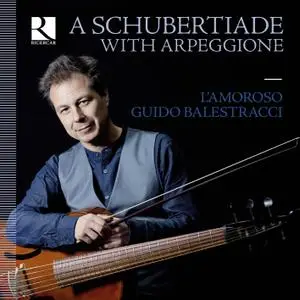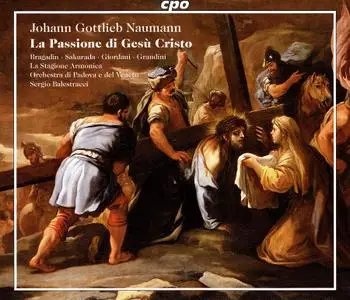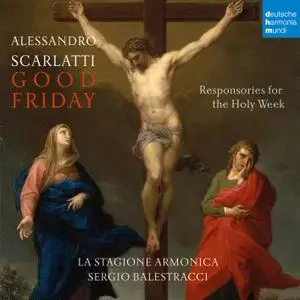Balestracci
L'Amoroso & Guido Balestracci - A Schubertiade with Arpeggione (2020) Music
Posted by delpotro at Jan. 17, 2020
L'Amoroso & Guido Balestracci - A Schubertiade with Arpeggione (2020)
WEB FLAC (tracks) - 258 Mb | MP3 CBR 320 kbps - 153 Mb | Digital booklet | 01:03:42
Classical | Label: Ricercar, Outhere Music
WEB FLAC (tracks) - 258 Mb | MP3 CBR 320 kbps - 153 Mb | Digital booklet | 01:03:42
Classical | Label: Ricercar, Outhere Music
The arpeggione, invented in 1823 by the Viennese luthier Johann Georg Stauffer, had a curious destiny. As its alternative names ‘guitar violoncello’ and ‘guitare d’amour’ suggest, it is in fact a guitar fitted with a bridge, held between the knees like a cello and played with a bow. The instrument enjoyed some success for around a decade, but, oddly enough, almost nothing has survived from its specific repertory except one supreme masterpiece: the sonata Franz Schubert wrote for it in 1824. The guitar was very popular in Vienna at that time, and Schubert was also fond of it; the original version of Die schöne Müllerin was published with guitar accompaniment! Guido Balestracci and the musicians of L’Amoroso have built a delightful Schubertiad around this famous sonata, combining the arpeggione and the piano with voice and guitars to appropriate a rich selection of the Viennese composer’s lieder.
Guido Balestracci, Blandine Rannou - Johann Sebastian Bach: Sonates pour viole de gambe et clavecin obligé (2007) Music
Posted by ArlegZ at Oct. 4, 2024
Guido Balestracci, Blandine Rannou - Johann Sebastian Bach: Sonates pour viole de gambe et clavecin obligé (2007)
EAC | FLAC | Image (Cue & Log) ~ 357 Mb | Total time: 56:26 | Scans included
Classical | Label: Zig Zag Territoires | ZZT070101 | Recorded: 2006
EAC | FLAC | Image (Cue & Log) ~ 357 Mb | Total time: 56:26 | Scans included
Classical | Label: Zig Zag Territoires | ZZT070101 | Recorded: 2006
Bach wrote these sonatas at Cothen between 1717 and 1723, probably to be played by the court virtuoso Carl Friedrich Abel or by Prince Leopold in person. While works for cello were invading Europe, Germany continued to give an important role to the viol throughout the eighteenth century, as can be seen in the works of such composers as Bach, Telemann, Abel, and Schaffrath (honoured by Guido Balestracci's most recent recording).
La Stagione Armonica, Sergio Balestracci - Scarlatti: Responsories for Holy Week - Holy Saturday (2018) Music
Posted by tirexiss at March 10, 2019
La Stagione Armonica, Sergio Balestracci - Scarlatti: Responsories for Holy Week - Holy Saturday (2018)
EAC | FLAC (image+.cue, log) | Covers Included | 70:20 | 342 MB
Genre: Classical, Sacred | Label: Deutsche Harmonia Mundi | Catalog: 19075802412
EAC | FLAC (image+.cue, log) | Covers Included | 70:20 | 342 MB
Genre: Classical, Sacred | Label: Deutsche Harmonia Mundi | Catalog: 19075802412
It is not certain that all the music on this disc is by Scarlatti; the manuscript that contains the nine Tenebrae Responsories for Holy Saturday and four Lenten motets is unsigned and in places incomplete. Conductor Sergio Balestracci is confident of their authorship, however, on stylistic grounds and because Scarlatti is reported to have composed settings of these Passiontide meditations in ‘the solid style of Palestrina’ for the Grand Duke of Tuscany in 1708.
Guido Balestracci, Paolo Corsi & Stéphanie Houillon - Virtuosity and Grace. Sonatas for Viola da Gamba (2023) [24/192] Vinyl & HR
Posted by delpotro at April 18, 2023
Guido Balestracci, Paolo Corsi & Stéphanie Houillon - Virtuosity and Grace. Sonatas for Viola da Gamba (2023)
FLAC (tracks) 24-bit/192 kHz | Front Cover & Digital Booklet | Time - 76:37 minutes | 2,63 GB
Classical | Label: Arcana, Official Digital Download
FLAC (tracks) 24-bit/192 kHz | Front Cover & Digital Booklet | Time - 76:37 minutes | 2,63 GB
Classical | Label: Arcana, Official Digital Download
This album is a story of family and friendship. Positioned between homage to a father figure and modernity, the viola da gamba sonatas of Carl Philipp Emanuel and Johann Christian Bach are a revealing element in the history of the Bach family and its ties of friendship with two families of virtuoso instrumentalists, the Abels and the Hesses, who had already inspired the work of Johann Sebastian.
Guido Balestracci, Paolo Corsi & Stéphanie Houillon - Virtuosity and Grace. Sonatas for Viola da Gamba (2023) Music
Posted by delpotro at April 18, 2023
Guido Balestracci, Paolo Corsi & Stéphanie Houillon - Virtuosity and Grace. Sonatas for Viola da Gamba (2023)
WEB FLAC (tracks) - 392 Mb | MP3 CBR 320 kbps - 180 Mb | Digital booklet | 01:16:37
Classical | Label: Arcana, Outhere Music
WEB FLAC (tracks) - 392 Mb | MP3 CBR 320 kbps - 180 Mb | Digital booklet | 01:16:37
Classical | Label: Arcana, Outhere Music
This album is a story of family and friendship. Positioned between homage to a father figure and modernity, the viola da gamba sonatas of Carl Philipp Emanuel and Johann Christian Bach are a revealing element in the history of the Bach family and its ties of friendship with two families of virtuoso instrumentalists, the Abels and the Hesses, who had already inspired the work of Johann Sebastian.
Bruno Cocset, Guido Balestracci, Les Basses Réunies - Diego Ortiz: Trattado de Glosas (2020) Music
Posted by ArlegZ at May 24, 2023
Bruno Cocset, Guido Balestracci, Les Basses Réunies - Diego Ortiz: Trattado de Glosas (2020)
EAC | FLAC | Image (Cue & Log) ~ 288 Mb | Total time: 59:31 | Scans included
Classical | Label: Alpha | # ALPHA563 | Recorded: 2019
EAC | FLAC | Image (Cue & Log) ~ 288 Mb | Total time: 59:31 | Scans included
Classical | Label: Alpha | # ALPHA563 | Recorded: 2019
Born in Toledo, Diego Ortiz published the Trattado de Glosas in Rome in 1553. At that time he was living in Naples in the service of Ferdinand Álvarez de Toledo, Duke of Alba and Viceroy of Naples. This region was deeply influenced by Spain. His treatise, published simultaneously in Spanish and Italian, is first and foremost a precious source for the art of Spanish instrumental performance. The second book of the Trattado de Glosas is performed here in its entirety, with Bruno Cocset and Guido Balestracci alternating in the Recercadas. As a counterpoint to this corpus mingling inventiveness and virtuosity, the programme includes short pieces by composers emblematic of the Golden Century of Spain, contemporaries of Ortiz: Antonio de Cabezón, Luis de Milán and Tomás Luis de Victoria.
Sergio Balestracci, Orchestra di Padova e del Veneto - Johann Gottlieb Naumann: La Passione di Gesù Cristo (2008) Music
Posted by ArlegZ at Oct. 31, 2020
Sergio Balestracci, Orchestra di Padova e del Veneto - Johann Gottlieb Naumann: La Passione di Gesù Cristo (2008)
EAC | FLAC | Image (Cue & Log) ~ 508 Mb | Total time: 120:04 | Scans included
Classical | Label: CPO | # 777 365-2 | Recorded: 2006
EAC | FLAC | Image (Cue & Log) ~ 508 Mb | Total time: 120:04 | Scans included
Classical | Label: CPO | # 777 365-2 | Recorded: 2006
JJohann Gottlieb Naumann, a contemporary of Joseph Haydn, was associated with Dresden, worked in Sweden and travelled in Italy. In his Passione di Gesù Cristo he concentrates on smaller scale emotions and conflicts – albeit in the context of the (conventional) Passion story. It was written, probably, in 1767. That’s quite an undertaking for a twenty-six year old, although Naumann already had several other vocal and choral successes to his name.
Sergio Balestracci, La Stagione Armonica - Alessandro Scarlatti: Responsories for the Holy Week - Good Friday (2020) Music
Posted by ArlegZ at Jan. 4, 2025
Sergio Balestracci, La Stagione Armonica - Alessandro Scarlatti: Responsories for the Holy Week - Good Friday (2020)
EAC | FLAC | Image (Cue & Log) ~ 344 Mb | Total time: 68:01 | Scans included
Classical | Label: Deutsche Harmonia Mundi | 19075940772 | Recorded: 2018
EAC | FLAC | Image (Cue & Log) ~ 344 Mb | Total time: 68:01 | Scans included
Classical | Label: Deutsche Harmonia Mundi | 19075940772 | Recorded: 2018
When it comes to old Italian vocal music, the Italian choir "La Stagione Armonica" from Padua under the direction of Sergio Balestracci has proven its high musical level several times. After the recording with responsories, which Alessandro Scarlatti composed for Good Saturday, the follow-up album with Scarlatti's responsories for Good Friday is now released.
La Stagione Armonica & Sergio Balestracci - A. Scarlatti: Responsories for the Holy Week: Good Friday (2020) Music
Posted by delpotro at March 20, 2020
La Stagione Armonica & Sergio Balestracci - A. Scarlatti: Responsories for the Holy Week: Good Friday (2020)
WEB FLAC (tracks) - 332 Mb | MP3 CBR 320 kbps - 164 Mb | 01:11:3
Classical, Sacred, Choral | Label: deutsche harmonia mundi
WEB FLAC (tracks) - 332 Mb | MP3 CBR 320 kbps - 164 Mb | 01:11:3
Classical, Sacred, Choral | Label: deutsche harmonia mundi
When it comes to old Italian vocal music, the Padua-born Italian choir "La Stagione Armonica" under the direction of Sergio Balestracci has repeatedly demonstrated its high musical level: "The sound they produce is extremely appealing in its firm expressiveness and in the way in which Balestracci's interpretive details somehow create a hint of simple but fervent piety, "wrote the press about his album on deutsche harmonia mundi with the responses that Alessandro Scarlatti composed for Holy Saturday.
Guido Balestracci, Les Basses Réunies & Bruno Cocset - Hume: "Harke, Harke!" Lyra Violls Humors & Delights (2014) [24/96] Vinyl & HR
Posted by SERTiL at March 21, 2018
Guido Balestracci, Les Basses Réunies & Bruno Cocset - Hume: "Harke, Harke!" Lyra Violls Humors & Delights (2014)
FLAC (tracks) 24-bit/96 kHz | Time - 70:15 minutes | 1.20 GB
Studio Master, Official Digital Download | Artwork: Digital Booklet
FLAC (tracks) 24-bit/96 kHz | Time - 70:15 minutes | 1.20 GB
Studio Master, Official Digital Download | Artwork: Digital Booklet
With this new recording, Bruno Cocset’s Les Basses Réunies propose a journey back to 17th-century England, centring on the work of Tobias Hume, an emblematic musician of the viola da gamba and, more precisely, the lyra violl. This exploration in terms of music as much as of sound, presents three instruments that have just come from the hands of instrument-maker Charles Riché (seconded by Friederike Dangel). A distinguished guest, the talented Italian gambist Guido Balestracci, plays a selection of solo pieces by the famous soldier composer.


![Guido Balestracci, Paolo Corsi & Stéphanie Houillon - Virtuosity and Grace. Sonatas for Viola da Gamba (2023) [24/192]](https://pixhost.icu/avaxhome/39/29/009d2939_medium.jpg)



![Guido Balestracci, Les Basses Réunies & Bruno Cocset - Hume: "Harke, Harke!" Lyra Violls Humors & Delights (2014) [24/96]](https://pixhost.icu/avaxhome/10/82/00528210_medium.jpg)